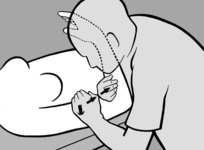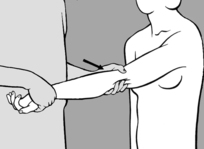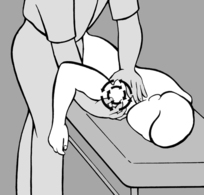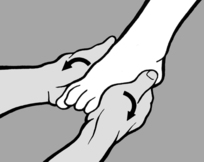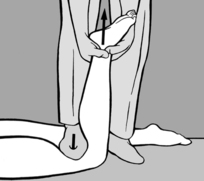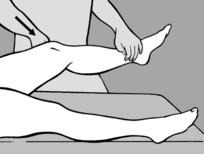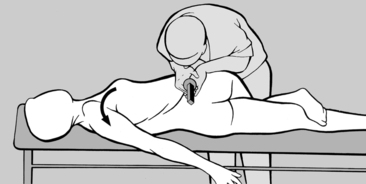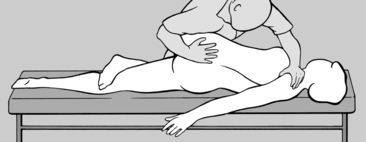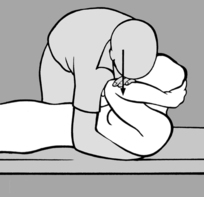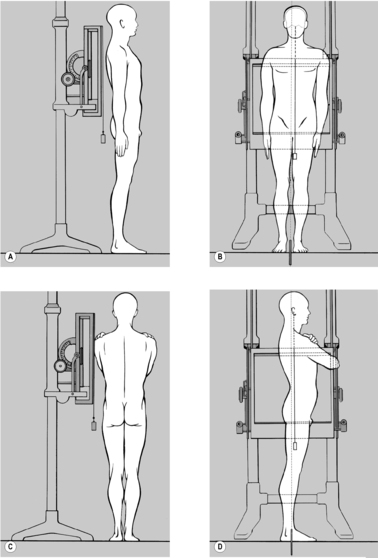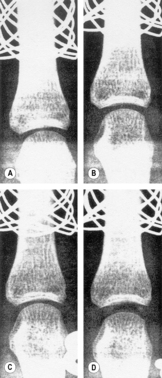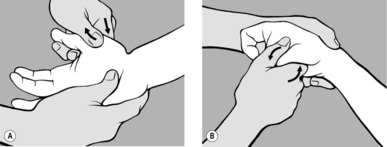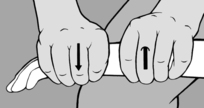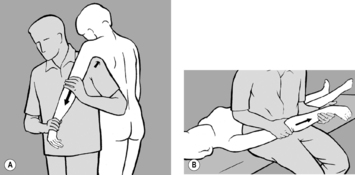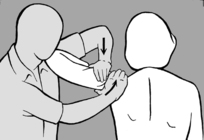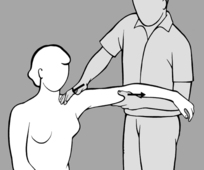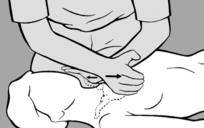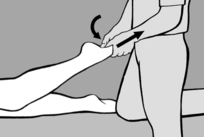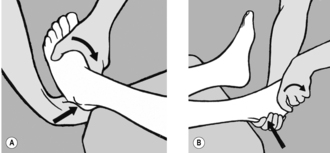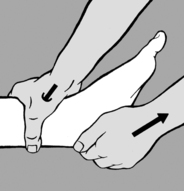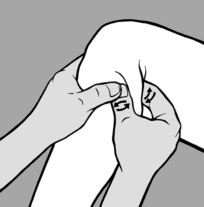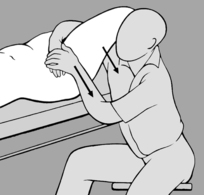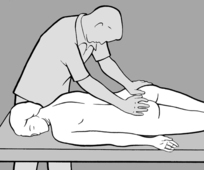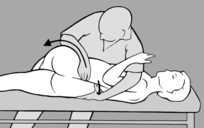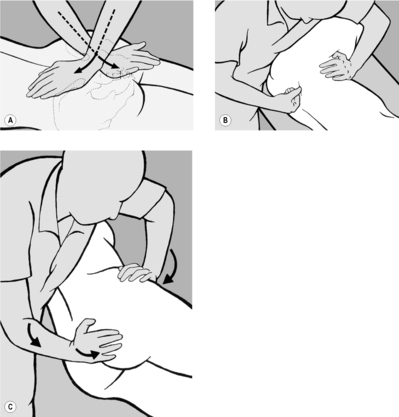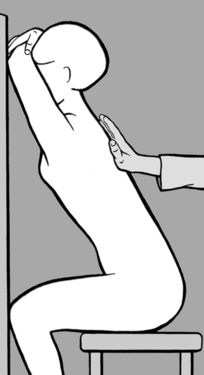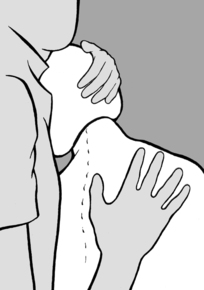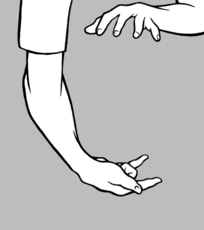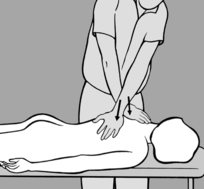Mobilization
For the thoracic spine there are no ‘pure’ traction techniques such as are used in the lumbar and cervical regions. There is one maneuver that is very popular among lay practitioners and corresponds approximately to traction manipulation. For this, the patient stands or sits with arms folded across the chest. From behind, the practitioner cups the patient’s right elbow with his left hand and left elbow with his right hand and presses the slightly kyphotic patient to his chest to take up the slack. From this position he straightens up and, delivering a thrust to the patient’s elbows, draws the patient upward and at the same time closer to his chest. This unsophisticated technique is quite innocuous unless the patient suffers from osteoporosis.
Because kyphosis with a stiff, rounded back is a particularly common disorder in the thoracic region,
mobilization into extension is the technique most frequently called for. In order to make full use of the patient’s own musculature, we do not employ standard PIR but instead utilize the active contraction of the erector spinae muscles during exhalation to achieve mobilization into dorsiflexion. Seated on a stool facing a wall, the patient stabilizes both knees (slightly apart) and with crossed arms against the wall, rests the head on the arms. The practitioner stands behind the patient, and places one hand or just one finger on a spinous process in the stiffened spinal segment to indicate to the patient where attention should be focused (see
Figure 6.38). Next, he instructs the patient to relax into extension. When maximum extension has been reached, he tells the patient to press lightly against his fingers and to breathe in deeply and slowly, breath-hold, and then breathe out slowly and completely. While breathing out, the patient should be told to straighten up again and to go into extension at the point where the practitioner’s finger can be felt. If performed correctly with sufficiently deep
exhalation, this technique produces powerful contraction of the erector spinae accompanied by an intensive mobilizing effect that the patient experiences as being slightly painful. As soon as the patient has understood and felt this, the technique can then be practiced (and repeated) as self-treatment on a daily basis.However, this very simple and effective technique has one major drawback: many patients with a kyphotic back have thoracolumbar hyperlordosis or at least hypermobility in that area and are unable to prevent themselves going into hyperlordosis there – something that must be avoided at all costs. Consequently, this technique should only be used in cases where the practitioner is satisfied that the patient is capable of extension, especially in the mid-thoracic part of the spinal column. Extension is frequently also rendered difficult because the erector spinae muscle is less well developed in the mid-thoracic region and most powerfully developed in the thoracolumbar segment. Therefore a more demanding technique is usually preferred, and this is described as a self-treatment method in Section 6.10.4.
If the intention is to treat just one
restricted segment, then the procedure is similar to that for examination with the patient side-lying with both hands clasped behind the head. The practitioner stands in front of the patient and with one hand grasps both the patient’s elbows brought together in front of the neck, while using the forefinger of his other hand to stabilize the spinous process of the lower vertebra in the restricted segment. Using his forefinger as a fulcrum, he moves the patient into retroflexion to take up the slack (see
Figure 6.39). The patient then uses the elbows to exert light (isometric) pressure against the practitioner’s arm and breathes in. He next instructs the patient to breathe out as fully as possible. As exhalation reaches the maximum, the erector spinae tenses and the thoracic spine is mobilized into extension. Here, too, it is the synkinetic tensing of the erector spinae during maximal (active) exhalation that is utilized for mobilization. This is therefore not a straightforward relaxation phenomenon such as occurs in PIR.
For
mobilization into anteflexion, the technique used is the same as that described for examination (see
Figure 4.22). To take up the slack, the patient is brought into kyphosis, with the peak of the kyphosis being at the level of the restricted segment. The patient is told to look up and breathe in, to breath-hold, and then to look down and breathe out. During slow exhalation, the patient relaxes and the thoracic spine becomes kyphosed. However, this kyphosis must be controlled so that its peak always remains within the treated segment. This mobilization procedure is repeated two or three times.
Anteflexion restrictions are most common where the upper thoracic spine is flattened and they tend to be associated with tension (TrPs) of the
erector spinae, usually on one side. Therefore mobilization can also be achieved by
relaxing this muscle. The practitioner stands behind the patient who is seated on the treatment table; with one hand he grasps the patient’s head, placing his palm on the occiput on the side of the lesion (i.e. his left hand is used if the lesion is on the right) (see
Figure 6.40). He moves the patient’s head into anteflexion, side-bending, and rotation to the opposite side to take up the slack. Using the thumb of his other hand, he fixes the spinous process of the lower vertebra in the segment to be treated. The patient is then told to look in the opposite direction (toward the side of the restriction) and breathe in, to breath-hold, and then to look in the direction of mobilization and breathe out slowly, during which anteflexion, side-bending, and rotation will be found to increase. This procedure can be repeated two or three times. For specific treatment, it is important to start with anteflexion until the restricted segment is reached (i.e. begins to flex), and only then to move on to head side-bending and rotation.
The practitioner stands behind the seated patient and, placing his hand on the opposite shoulder, bends the patient’s trunk sideways to take up the slack. With his other hand at the level to be treated, he stabilizes the ribs while using his thumb to brace the spinous process of the lower vertebra in the restricted segment. If an even-numbered segment is being treated, he instructs the patient during the isometric phase to look up, breathe in, and hold the breath. It will be noted how resistance to side-bending increases. The patient is then told to relax and breathe out; the practitioner waits until relaxation is complete. In the odd-numbered segments (excluding T1/T2), the patient is simply instructed to breathe in slowly and deeply, to breathe out, and then to breathe in slowly again; the practitioner will sense how resistance increases during exhalation and how relaxation occurs during inhalation. In principle, the patient should avoid looking down during relaxation because this would encourage anteflexion. Mobilization can be repeated two or three times. If counting the segments is too onerous, it is equally reliable to ask the patient to breathe in and out just to see what happens. It will be very apparent whether resistance in the segment in question increases or decreases. However, the difference becomes less clear in the caudal segments because inhalation has a stabilizing effect and the quadratus lumborum becomes tense during inhalation.
Technically, it is critical to wait for the relaxing effect of inhalation on the one hand and of exhalation on the other; relaxation can occur at a relatively late stage during exhalation or inhalation. The practitioner’s stabilizing hand must also provide the patient with good support from the side to allow relaxation to take place; during side-bending the spinous process automatically moves closer to the fixing thumb due to simultaneous rotation of the thoracic spine.
However, if the patient has very broad shoulders and the practitioner has small hands, it is possible to use the technique described in the context of examination (see
Figure 4.24). The practitioner stands behind the seated patient on the side into which side-bending is to occur. He tells the patient to raise the upper arm on the opposite (far) side. Taking hold of the upper arm from the front, he uses the thumb of his other hand to fix the spinous process of the lower vertebra in the segment to be treated. With his hand on the patient’s upper arm, the practitioner brings the patient into side-bending and so takes up the slack. Depending on whether the segment is even- or odd-numbered, mobilization is performed in the appropriate way. It must be stressed that during this technique the practitioner needs to lean backward and bend his knees. It is also remarkable that during mobilization into side-bending the vertebrae move closer together on the side in question and thus exert a mobilizing effect on the interposed tubercle of rib.
For mobilization in rotation, the patient sits (with hands clasped behind the neck) in a slightly kyphotic position astride the end of the treatment table. The practitioner stands behind the patient and passes one arm under the patient’s axilla to grasp the opposite shoulder. He places his other hand on the patient’s back to stabilize it. The patient is then told to look at an object in the examination room placed in such a way as to necessitate trunk rotation in that direction, thus taking up the slack. Next the patient is instructed to look in the opposite direction and to breathe in. The practitioner offers isometric resistance in the opposite direction against automatic rotation. After breath-holding, the patient is again told to keep looking in the direction of mobilization and to breathe out. This can be repeated two or three times. RI is then performed by instructing the patient (in the newly gained rotation position) to offer resistance in the opposite direction against repeated pressure.
Because the three muscles mentioned above form a chain, trunk rotation can also be restored by relaxation of the psoas major or quadratus lumborum.

